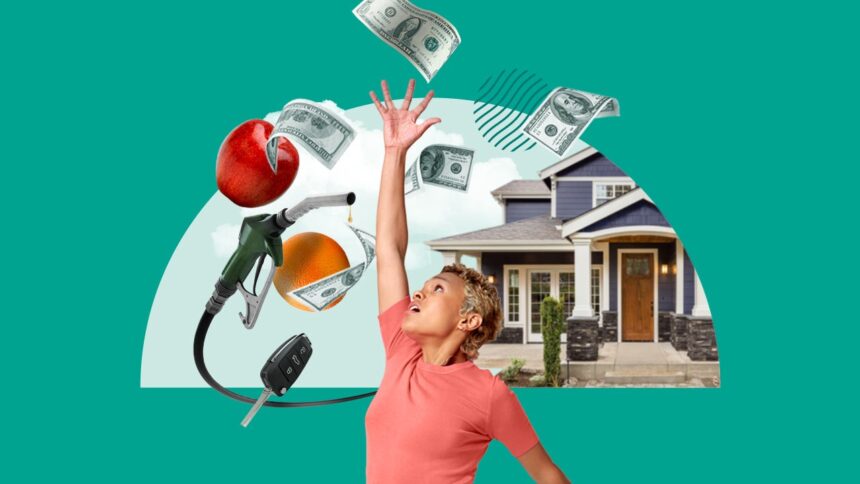Key takeaways
- Inflation is a sustained enhance in costs of products and providers, which might negatively affect buying energy and result in powerful monetary choices for shoppers.
- The Federal Reserve targets a 2% annual inflation charge as an indication of a wholesome economic system.
- Inflation will be attributable to elements equivalent to elevated manufacturing prices or excessive demand for items and providers, and expectations for greater inflation may also contribute to rising costs.
Nobody needs to take a pay reduce — however with inflation, People typically haven’t any alternative.
As People emerged from coronavirus pandemic lockdowns with money to burn and a willingness to spend, inflation grew to become an actual risk to each family earnings and the broader economic system for the primary time because the Eighties. It’s an financial phenomenon that has a nasty popularity amongst policymakers, traders and shoppers alike. Costs have surged 20.9 % since February 2020, when the outbreak-induced recession started, in keeping with the Nationwide Bureau of Financial Analysis. It implies that People would want about $1,209 to purchase the identical items and providers that initially value $1,000.
Excessive inflation has penalties past simply affordability, complicating saving for emergencies or investing for retirement. To not point out, officers on the Federal Reserve quickly raised rates of interest to get the burst in U.S. cost-of-living underneath management, even when it meant risking a recession or a slowdown within the job market.
However not all inflation is unhealthy inflation, and costs rise and fall throughout the economic system on a regular basis as a result of supply- and demand-related elements. Right here’s a breakdown of what inflation is and isn’t, in addition to why it issues a lot on your pockets.
The newest insights on inflation
- Newest year-over-year inflation charge (July 2024): 2.9%
- Excluding meals and vitality: 3.2%
- Fed’s official inflation goal: 2%
What’s inflation?
Inflation happens when the gadgets that customers usually purchase — from providers equivalent to haircuts or medical care to items together with home equipment and furnishings — enhance over a sustained time period. Inflation doesn’t occur in a single day, and it additionally doesn’t occur when the price of one explicit product will increase.
Say you go to the grocery retailer and purchase a dozen eggs for $2. Then, the following week, that very same product is now $4. That worth soar alone doesn’t depend as inflation, as costs within the monetary system consistently fluctuate — meals and vitality prices particularly. As an alternative, inflation applies to the broader image.
“We may even see costs rise on sure issues like fuel or milk, however it’s not essentially inflation until you see costs rising form of throughout the board, throughout many various services,” says Jordan van Rijn, who teaches agricultural and utilized economics on the College of Wisconsin’s Heart for Monetary Safety.
How a lot inflation is an excessive amount of inflation?
Yearly, costs needs to be rising all through the U.S. economic system. Slightly little bit of inflation is seen as an indication of a wholesome economic system, serving to guarantee companies can maintain hiring and shoppers’ paychecks can continue to grow. Fed officers goal a 2 % annual inflation charge — now the frequent goalpost for inflation thought of to be good.
“That principally offers the economic system the flexibility to slowly elevate costs,” says John Cunnison, CFA, vp and chief funding officer at Baker Boyer Financial institution. “For firms, they’ll slowly enhance folks’s wages. You’re actually wanting on the goldilocks inflation — not too little, not an excessive amount of.”
The wallet-harming type of inflation, nevertheless, occurs when costs burst at a charge a lot quicker than 2 % and People’ paychecks can’t sustain. Customers find yourself having to make powerful choices about what to purchase and what to carry off on. Typically, they could haven’t any means of avoiding these worth pressures if inflation is impacting key necessities, turning to bank card debt. Unpredictable worth will increase may also be a difficulty for the economic system, making it tougher for companies to cost set and put together for the long run.
How inflation is measured
Primarily, there are two predominant methods to measure inflation:
- The Bureau of Labor Statistics’ shopper worth index (CPI); and
- The Division of Commerce’s private consumption expenditures (PCE) index.
CPI issues primarily for shoppers. BLS usually offers info on how costs are altering on virtually 400 particular person gadgets, getting as particular as peanut butter or stationery. The Social Safety Administration (SSA) makes use of a subset of CPI to find out its annual cost-of-living adjustment (COLA), whereas the Inside Income Service (IRS) even makes use of CPI to tell changes to federal tax brackets — making the index consequential for tons of of thousands and thousands of People.
PCE, then again, is essential for the Fed — however its affect on shoppers remains to be enormous, albeit oblique. Policymakers use this gauge to assist decide what to do subsequent with their key benchmark rate of interest that influences how a lot shoppers pay to borrow cash. Formally, they aim PCE, as a substitute of CPI.
That choice issues as a result of the 2 indexes present totally different photos of inflation. Whereas each measures seize the identical developments, CPI has traditionally tended to rise quicker than PCE, primarily as a result of the indexes use totally different formulation and weights to calculate inflation. Shelter, as an example, is taken into account one of the vital gadgets within the total CPI index — coincidentally one of many hottest corners of inflation proper now. That is likely to be why costs have risen 2.9 % from a yr in the past, in keeping with BLS’ calculations, four-tenths of a share level above the general inflation charge of two.5 % in PCE.
In the meantime, CPI seems to be completely at how a lot shoppers pay for particular items and providers, whereas PCE seems to be at each shopper knowledge and enterprise expenditures. PCE additionally takes shoppers’ substitutions into consideration. Somebody who replaces meats with seafood one month as a result of it’s cheaper, for instance, won’t see as excessive of meals prices.
How economists observe inflation
To get a way of the broader inflationary image, economists usually observe year-over-year modifications within the total worth index stage, which helps squeeze out short-term will increase or dips in addition to seasonal elements. In addition they analyze three- and six-month shifting averages to assist shine a light-weight on current developments. Stripping out the unstable meals and vitality classes, in the meantime, generates a take a look at underlying inflation, sometimes called “core” costs.
How shoppers observe inflation
Households, nevertheless, have fully totally different perceptions of the U.S. economic system.
For starters, not all households purchase the identical items. The inflation charge shoppers expertise is determined by what they purchase, which means somebody’s private inflation charge would possibly find yourself being decrease, or greater, than the general index. Drivers, for instance, is likely to be coping with a larger inflationary pinch than somebody who takes public transportation, as insurance coverage and restore prices proceed to surge. Households may also really feel like inflation is even worse in the event that they’re sending their youngsters off to varsity or paying for medical care — two classes which have outpaced total inflation.
One other key distinction: Inflation charges are totally different than worth ranges. Whilst inflation slows, households have a tendency to recollect how a lot it used to value to refill their fuel tank or purchase their groceries for the week.
What are the causes of inflation?
Economists primarily lump the causes of inflation into two classes: demand-pull and cost-push inflation. These phrases sound wonky, however they replicate experiences that many People are accustomed to — particularly after the coronavirus pandemic.
But, different forces that don’t clearly match into any class will be at play. And as was the case after the outbreak, all of these inflationary forces can intersect, making a worth drawback that’s much more troublesome to unravel.
1. Value-push inflation
Value-push inflation happens when costs enhance as a result of manufacturing is costlier — whether or not it’s due to greater wages or materials costs. Firms go alongside these greater bills by elevating costs, which then cycles again into the price of residing.
Actual-world instance
Larger lumber prices, costlier vitality or electrical energy payments and pricier meals bills post-pandemic compelled builders, factories and even eating places to lift costs.
2. Demand-pull inflation
On the flip aspect, demand-pull inflation happens when shoppers have resilient curiosity for a service or good. Such demand might outcome from issues like a low jobless charge, robust shopper confidence or low rates of interest. Firms, nevertheless, can’t at all times sustain with that strong demand, resulting in product shortages and, consequently, worth surges.
You might have an economic system that revs up in a short time and you find yourself with demand-pull inflation, the place there’s an excessive amount of cash chasing too few items and providers.
— Greg McBride, Bankrate Chief Monetary Analyst
Actual-world instance
Huge pent-up demand and a stockpile of financial savings because of lockdowns helped push up costs for the experiences shoppers have been disadvantaged of: journey, live shows and sporting occasions in addition to eating out.
3. Expectations for greater inflation
Even the mere expectation of upper costs could be a unhealthy prophecy. If shoppers begin anticipating costs to pop, they’re extra more likely to panic purchase or demand greater wages. These two forces mixed create the very phenomenon shoppers have been frightened about.
“If folks assume inflation will probably be excessive, costs are going to proceed to rise,” says van Rijn. “When you’re an govt setting wages at your organization, that relies upon somewhat bit in your expectations for a way a lot costs are going to extend subsequent yr. As wages go up, then the identical factor occurs with companies — they’re going to begin elevating their costs.”
Actual-world instance
As shoppers tried to catch as much as the huge burst in post-pandemic costs, employees stated in a 2023 Bankrate survey that greater pay was crucial high quality of their employment shifting ahead, whereas virtually half (47%) stated they have been more likely to ask for a elevate.
| Components that warmth up inflation | Components that cool inflation |
|---|---|
| Elevated shopper or authorities spending, particularly spending that takes on debt | Decreased shopper or authorities spending |
| Growing cash provide | Lowering or slower-growing cash provide |
| Deficit spending, that’s, decrease taxes with out corresponding cuts in authorities spending | Authorities surpluses, that’s, tax revenues are larger than spending |
| Rates of interest which are beneath the impartial charge of inflation, or will increase within the cash provide | Rates of interest which are above the impartial charge of inflation, or declines within the cash provide |
| Extremely consolidated industries that push by worth will increase or go on their very own value will increase | Fragmented industries which have little pricing energy |
| A wage-price spiral, through which rising wages push up the worth of products and so employees demand greater wages to compensate | Customers saving greater than they did earlier than, or will increase within the web saving charge |
| Expectations of upper inflation sooner or later | Expectations of decrease inflation sooner or later |
| Provide shocks that sharply scale back output, such because the oil shock of the Nineteen Seventies | Quickly growing provide, maybe by a technological breakthrough |
| Elevated shopper demand, because of an enhancing job market and widespread employment | Slumping demand, doubtless attributable to a soar in joblessness or a recession |
Transient historical past of U.S. inflation
Excessive inflation was final a serious drawback throughout the Nineteen Seventies and Eighties — reaching 12.2 % in 1974 and 14.6 % in 1980 — when the central financial institution didn’t curb demand sufficient with greater rates of interest throughout a time of huge authorities spending and two oil-price shocks.
Then-Fed Chair Paul Volcker determined to drastically change the best way Fed officers set rates of interest and push these borrowing prices all the best way as much as a spread of 19-20 %, the best goal vary for the benchmark federal funds charge on file. Unemployment spiked, and the economic system confronted its worst recession because the Nice Melancholy. Nevertheless painful, the technique labored. Inflation steadily cooled by the primary half of the last decade, sinking to 1.2 % by December 1986.
Since then, inflation hadn’t proved to be a lot of a risk — till now. Costs rose a mean of two.4 % a yr between 1990 and the tip of 2019, and inflation popping out of the Nice Recession of 2007-2009 proved to be tepid at finest regardless of ultra-low rates of interest. Economists primarily blamed a sluggish post-financial disaster restoration, together with different disinflationary elements, equivalent to globalization, technological improvements and an growing old inhabitants. However shoppers is likely to be shocked to recall that the Fed spent the period really fearing too-low inflation, pondering that it’d make it tougher to stimulate the economic system if a recession have been to happen.
What is the newest on inflation?
Try Bankrate’s evaluation on the place costs are at present rising essentially the most and what’s nonetheless costliest because the pandemic.
Learn extra
Forms of excessive inflation
Speedy inflation can at all times be painful, however there are different flavors of worth pressures that may be much more harmful for the economic system and People’ buying energy.
1. Stagflation
Stagflation happens when unemployment is rising, demand is slowing, financial progress is slipping — however contrarily, inflation isn’t budging. Sometimes, slowing progress and rising unemployment have an inverse relationship with inflation. Fewer paychecks weigh on spending; much less spending weighs on companies having the ability to increase or make investments.
Solely a set of particular situations result in this sort of inflation. Sometimes, provide shortages that proceed to weigh on the U.S. economic system’s productive capability are a predominant ingredient. There are additionally various levels of stagflation. Within the worst of situations, the monetary system may very well be in a recession as inflation surges. In milder, but nonetheless painful, circumstances, progress would possibly simply be lukewarm.
At any charge, the surroundings proves particularly difficult as a result of the normal means of controlling inflation — elevating rates of interest — isn’t as instantly efficient.
2. Hyperinflation
Hyperinflation happens when costs rise massively, typically thought of to be at a charge of round 50 % every month. Suppose: Twenties Germany or the present economies of Venezuela or Zimbabwe. However solely a uncommon mixture of policymaking missteps result in this surroundings, from exploding authorities spending and money owed to a speedy enhance within the nation’s cash provide.
How can shoppers defend in opposition to inflation
- Discover one of the best place to park your money: Not all inflation is unhealthy inflation, however shoppers who maintain their cash underneath the mattress or at a brick-and-mortar financial institution are certain to lose floor to inflation. Traditionally talking, investing in monetary markets has been one of the simplest ways to develop your buying energy over time, whether or not you’re 50 years or 50 days away from retirement. In the meantime, high-yield financial savings accounts are at present providing annual share yields (APYs) of 5 % or extra, eclipsing inflation.
- Preserve a funds: Durations of excessive inflation underscore the significance of retaining an in depth watch over your funds. Be sure to’re conscious of how a lot you’re spending and the way a lot you’ll be able to afford to spend.
- Store round for essentially the most inexpensive possibility: When costs are rising throughout the board, it’s onerous to flee inflation, however using expertise to search out the most cost effective product in the marketplace and examine choices might translate to important financial savings in the long term. Higher but, discover coupons or see if any retailers worth examine.
- Preserve an emergency fund: Customers might imagine it’s unwise to maintain an excessive amount of money on the sidelines after they’re fearful about dropping their buying energy, however it’s throughout these instances when they need to focus on increase a cushion of money they most. Excessive inflation means greater rates of interest, pushing up recession dangers and the price of borrowing on a bank card.








